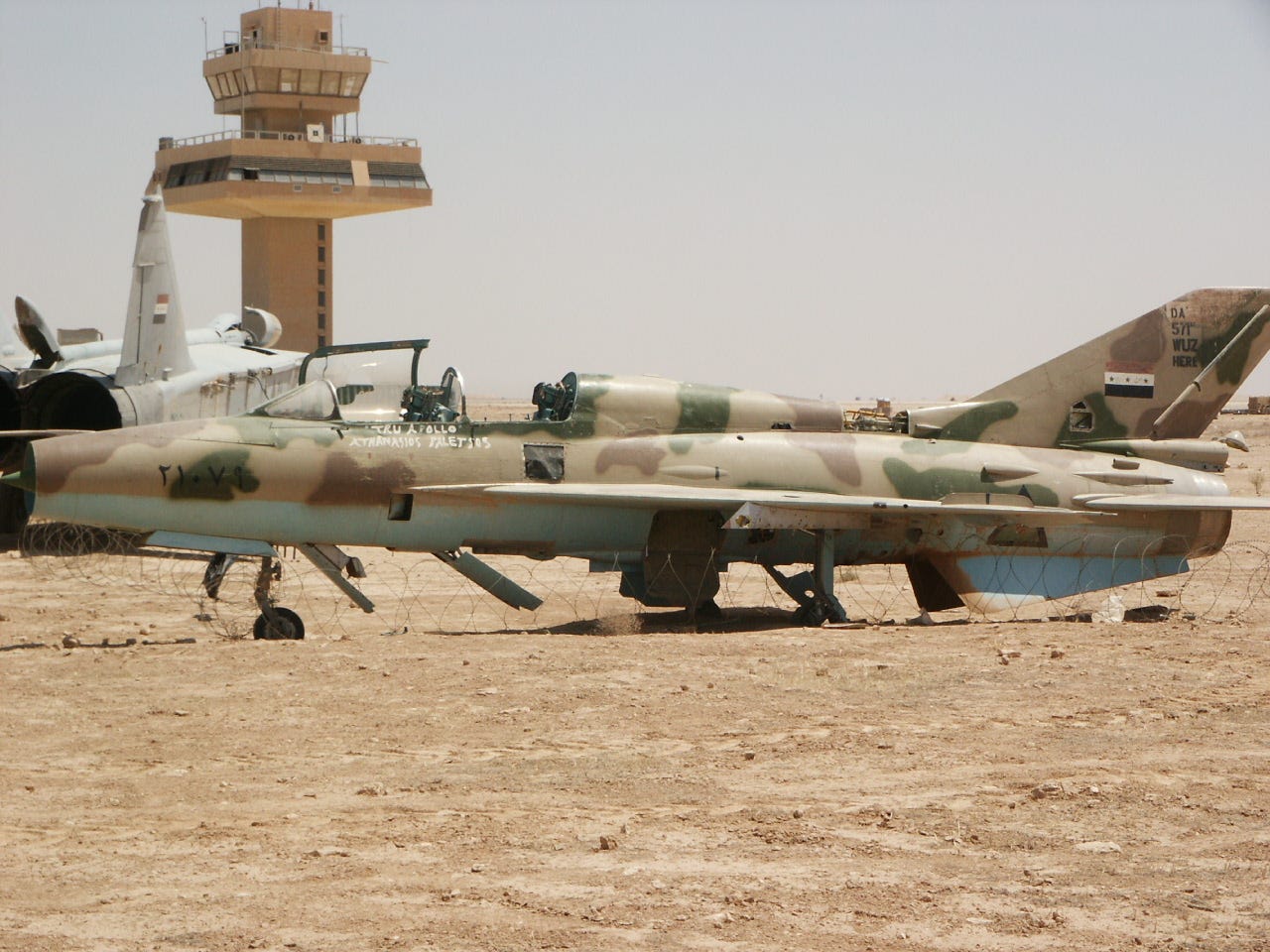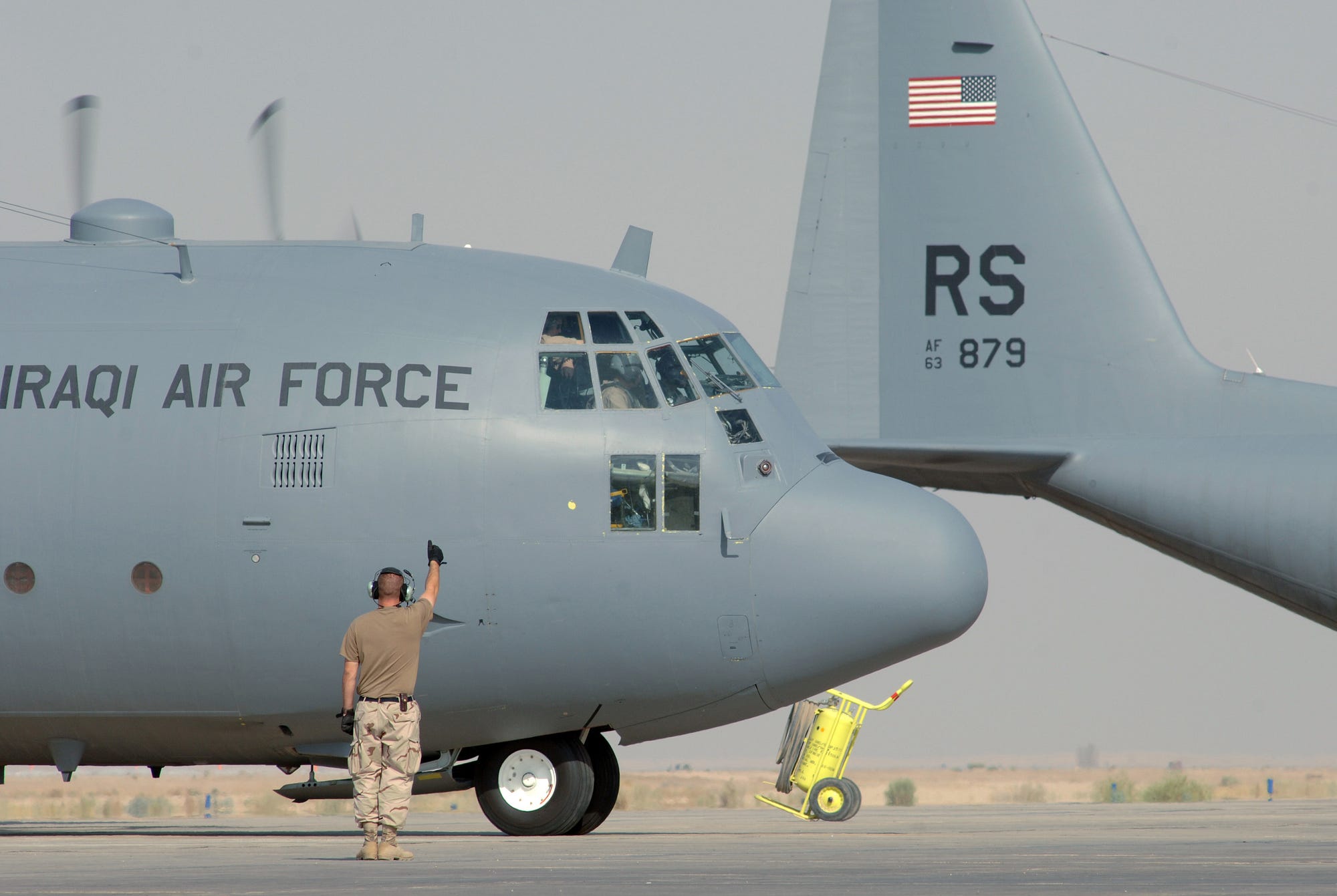Jul 12, 2014
How the U.S. screwed up the reconstruction of Iraqi military aviation
How did the United States screw up the Iraqi air force this badly? Militants from the Islamic State of Iraq and Syria occupy much of western Iraq, and so far Baghdad’s warplanes have put up only modest resistance.
In desperation, the Iraqi government organized a crash purchase of 12 ex-Russian Su-25 attack planes … and welcomed three Iranian Su-25s to Baghdad to help fly top cover for local ground troops.
It didn’t have to be this way.
Prior to 1991, Iraq flew one of the largest and most modern air forces in the Middle East. Effectiveness varied, but it had performed well at times in the Iran-Iraq War and was generally capable of undertaking all of the basic tasks that we expect air forces to perform.
The Iraqi air force consisted primarily of Soviet aircraft, but also included a selection of French fighters, including the Mirage F-1.
The Gulf War devastated the force, but didn’t completely destroy it. The coalition concentrated on destroying Iraqi aircraft on the ground and in the air, but a significant fraction of the fleet escaped to Iran, where the Iranians interned, cannibalized and re-used it to good effect.
Despite the impact of the Gulf War and long-term sanctions, the Iraqis could still maintain presence in the air up until 2003. An Iraqi MiG-25 shot down an American Predator drone over the northern no-fly zone in 2002.
But the 2003 U.S.-led invasion finished off the remnant Iraqi air force … and then the subsequent occupation really did a number on Baghdad’s potential to rebuild. Either the Iraqis or the Americans destroyed nearly all of the remaining aircraft, and the United States formally abolished the air force when it disbanded the rest of the Iraqi military in 2003.
Iraq is not a poor country, and it lives in a dangerous neighborhood. Baghdad needs military aviation, it can afford to buy and maintain advanced aircraft and it’s had an air force in the past. There’s no reason that Iraq should have gone for 11 years without usable, sophisticated military aviation.
The abolition of Iraqi president Saddam Hussein’s air arm left the country without even the nucleus for reconstruction. As with the Iraqi army, the U.S. authorities decided to abandon the vast reserve of human and organizational capital associated with Iraqi air power … and to start over from scratch.
It’s easy to appreciate why the U.S. was reluctant to rebuild the force from the available foundations. Hussein’s air force had deep-seated problems with training and maintenance, and in any case was shot through with Baathist sympathizers.
Plans for aerial reconstruction moved forward slowly, as the coalition authority determined that it could provide Iraq’s air-defense for the time being, using its own drones, fighters and bombers.
The new Iraqi air force acquired its first aircraft in January 2005, when the United States transferred three aged C-130s into Iraqi service. One of the C-130s is pictured above. Early efforts focused overwhelmingly on capabilities that could directly support U.S. and Iraqi ground forces—recon planes and transports, mostly.
Baghdad finally ordered 36 U.S.-made F-16 fighters starting in 2011, but the first of those just arrived in Iraq—too late to meaningful contribute in the country’s defense.
The American desire to rebuild Iraqi forces with primarily American aircraft complicated reconstruction efforts. The prospect of arms sales like the $3-billion F-16 deal wasn’t the only reason. Washington wanted Iraqi planes to be as interoperable as possible with its own squadrons.
But the Iraqis had virtually no experience maintaining complex U.S. aircraft, whereas many Iraqi airmen had spent fixing and flying simpler Soviet models. Even repair manuals proved problematic, as few Iraqis read sufficient English to be able to productively use the manuals.
The Royal Jordanian Air Force, which operates many of the same aircraft as the nascent Iraqi air arm, provided support along the way. But the Jordanians’ assistance couldn’t make up for fundamental problems in America’s approach to re-establishing Iraqi air power.
U.S. airmen grew increasingly frustrated with the apparent lack of Iraqi progress. As early as 2009, the think-tank RAND predicted that a U.S. withdrawal would leave a large gap in Iraq’s ability to defend its airspace and support its ground forces from the air.
The RAND report suggested that Iraq would not have full F-16 capability until potentially 2020, an estimate which remains depressingly on the mark.
In 2009, authorities discovered 19 old Iraqi MiG-21s and MiG-23s in crates in Serbia, but these jets never made their way back to Iraq, mostly because of concerns that they wouldn’t constitute a large enough fleet to justify training and maintenance costs. The Iraqis undoubtedly wish they had those fighters in service today.
 American policymakers calculated that the United States could provide all the attack aviation Iraq might need over the medium term. To introduce Iraqi attack aircraft prematurely would simply crowd the skies—and take assets and attention away from the more critical project of rebuilding Iraqi ground forces, they reasoned.
American policymakers calculated that the United States could provide all the attack aviation Iraq might need over the medium term. To introduce Iraqi attack aircraft prematurely would simply crowd the skies—and take assets and attention away from the more critical project of rebuilding Iraqi ground forces, they reasoned.
But everyone appreciated that Iraq eventually would need advanced fighter aircraft. For some states, F-16s amount merely to prestige weapons—great for air shows but useless in the kinds of wars they actually fight.
For Iraq, that’s not the case. Baghdad is surrounded by potential enemies with high-performance warplanes of their own. And militant groups like ISIS are increasingly heavily armed—and wholly capable of destroying the helicopters and light planes that, at present, constitute the Iraqi air arms’ main equipment.
So why did we slow roll the transfer of F-16s? Congressional politics has played an important role. Sen. Robert Menendez, a New Jersey Democrat,has long opposed the F-16 transfer, out of concern that Prime Minister Nouri Al Maliki’s government might eventually turn against U.S. interests.
Saudi Arabia and Israel also expressed worry over the export of F-16s to Iraq. With the long-term political orientation of the Iraqi government in doubt, Riyadh and Jerusalem saw some value in Iraqi dependence on the United States for its air defense.
Distractions stemming from organizational politics and defense-base concerns also created roadblocks. Tasked with developing the capability of partner air forces, the U.S. Air Force tried to acquire a squadron of A-29 Super Tucano propeller-driven attack planes from the Brazilian producer Embraer.
This contract proposal embroiled the Air Force in an apparently endless dispute with U.S. firm Hawker Beechcraft over the latter’s AT-6 aircraft, which the Air Force had excluded from the initial competition.
The Air Force intended the Tucanos to support the reconstruction of theAfghan air force, but the contract problem illustrates the difficulties that the U.S. faces in navigating its own defense bureaucracy with respect to enhancing the capabilities of its own allies.
Since 2003, the Iraqis have operated zero fixed-wing fighter-bombers. Pending the service-entry of F-16s and ex-Russian Su-25s, the reconstruction of the Iraqi air force has thus far amounted to helicopters and prop-driven training and transport planes.
Converted to attack tasks, these craft have helped—albeit at great cost to their poor pilots. But they don’t have the same capabilities as dedicated fighter and attack aircraft.
It’s easy to overstate the importance of air power in fighting an insurgent opponent like ISIS. Air power is attractive to leaders like Al Maliki because it represents a relatively uncomplicated means of projecting power over territory.
Also, pilots are fewer in number and easier to co-opt than infantry brigades. Moreover, air power has flexibility no domestic opponents can replicate. Indeed, the attractiveness of air power may be one reason that the United States proved so slow to offer Al Maliki this tool.
Full air-attack capacity won’t win the war for the Iraqi government. It will, however, give the government an advantage over the rebels—potentially enough of one to rally Iraqi ground forces to take back lost territory.
And the broader trend demonstrates that, in the long run, Iraq has options for advanced weaponry beyond the United States. If Iraq can’t acquire F-16s in a timely fashion, it will probably purchase Russian MiG-29s and Su-27s, if not Chinese J-10s and JF-17s.
The question isn’t will Iraq have advanced aircraft? Rather, it’s who will provide Iraq’s advanced aircraft, and who will train Iraqi pilots?
Perhaps most notably, the United States has failed to escape the perfection mindset. The Hussein-era Iraqi air force suffered from tremendous problems and inefficiencies, but it actually flew fighters and bombers. It could put up a real fight.
It’s true that air power can neither win the war against ISIS on its own nor resolve the basic political conflicts that wrack Iraqi society. But ISIS has seized power through what amounts to a conventional military offensive. Effective air power can do something about that, at least.
Moreover, the authority of central governments depends on their ability to project force within their own borders, and air power is a central aspect of this force projection.
Governments that can’t protect their citizens from non-state actors—and which lack the physical authority to carry out basic governance functions across their territory—cannot be expected to achieve an enduring political consensus.
Medium has an app! Sign up for a daily War is Boring email update here. Subscribe to WIB’s RSS feed here and follow the main page here.

No comments:
Post a Comment